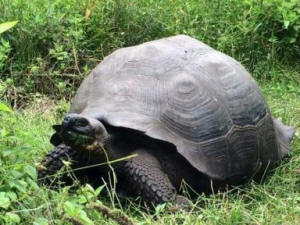|
 Shell
game: New species of Galapagos giant tortoise identified Shell
game: New species of Galapagos giant tortoise identified
 Send a link to a friend
Send a link to a friend
[October 22, 2015]
By Will Dunham
WASHINGTON (Reuters) - Scientists have
identified a new species of giant tortoise on the Galápagos Islands,
using genetic data to determine that a group of 250 of the slow-moving
grazing reptiles was distinct from other tortoise species residing in
the Pacific archipelago.
|
|
 The newly identified species lives in a 15-square-mile
(40-square-km) area of Santa Cruz Island and is as different
genetically from the other giant tortoise species on the island as
species from other islands, the scientists said on Wednesday. The newly identified species lives in a 15-square-mile
(40-square-km) area of Santa Cruz Island and is as different
genetically from the other giant tortoise species on the island as
species from other islands, the scientists said on Wednesday.
The research differentiated the new Eastern Santa Cruz tortoise,
given the scientific name Chelonoidis donfaustoi, from a larger
population of about 2,000 tortoises living about 6 miles (10 km)
away on the western part of the island that belong to the species
Chelonoidis porteri.
Scientists long had thought all the giant tortoises on the island
were from the same species.
"Its closest relative is not the species on the same island but a
species from the neighboring island to the east, San Cristobal,"
Yale University evolutionary biologist Adalgisa Caccone said.
 The researchers used two types of genetic data to determine that it
merited being recognized as a separate species, bringing to 15 the
number of Galápagos giant tortoise species.
In addition to genetic differences, the two Santa Cruz Island
species also differ in the shape of their shell, with the Eastern
Santa Cruz tortoise having one with a more compressed shape, Caccone
said. The newly identified species lives in a drier part of the
island, Caccone added.
Giant tortoises, which can reach some 500 pounds (225 kg) are among
the famous creatures of the Galápagos Islands closely studied by
19th century British naturalist Charles Darwin. "It is part of the
process of understanding the evolutionary history of this iconic
group that inspired Charles Darwin when he visited the islands and
certainly contributed to the development of his theory of evolution
via natural selection," Caccone said.
[to top of second column] |

The Galápagos Islands are one of only two locales inhabited by giant
tortoises, along with the Indian Ocean's Aldabra Atoll. Galápagos
tortoises graze on grasses, leaves, cactus and fruit but can survive
up to a year without food or water.
The tortoises, classified as endangered, were hunted almost to
oblivion by sailors who stashed them in the holds of ships as food
during lengthy sea voyages.
The new species' scientific name honors a recently retired National
Galápagos Park ranger named Fausto Llerena Sanchez.
The findings were published in the journal PLOS ONE.
(Reporting by Will Dunham; Editing by Sandra Maler)
[© 2015 Thomson Reuters. All rights
reserved.]
Copyright 2015 Reuters. All rights reserved. This material may not be published,
broadcast, rewritten or redistributed.
 |